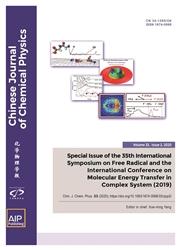二价阳离子诱导细胞膜融合的和频光谱研究
IF 1.2
4区 化学
Q4 PHYSICS, ATOMIC, MOLECULAR & CHEMICAL
引用次数: 0
摘要
细胞膜融合是一个涉及许多细胞生活功能的基本生物学过程。关于这一点,二价阳离子可以通过二价阳离子与带电脂质的结合和桥接来诱导脂质双层的融合,从而导致细胞膜融合。然而,二价阳离子诱导细胞膜融合的详细机制仍有待阐明。本文应用表面/界面敏感和频生成振动光谱(SFG-VS)和动态光散射(DLS)研究了磷脂单层对二价金属离子(Ca2+和Mg2+)暴露的响应。根据DLS实验测量的颗粒大小分布结果,发现Ca2+可以诱导泡间融合,而Mg2+不能。设计了一个十八烷基三氯氢硅自组装单层(OTS-SAM)-脂质单层系统来模拟SFG-VS实验的细胞膜。与Mg2+相比,Ca2+可以更强烈地与脂质PO2-头部基团相互作用,导致细胞膜更容易融合。在两种金属阳离子和C=O基团之间没有观察到特定的相互作用。然而,与Mg2+介导的脂质单层相比,Ca2+-PO2-结合后C=O取向的变化更大。同时,Ca2+可以诱导脂质脱水(这应该与Ca2+-PO2-的强烈相互作用有关),从而减少对细胞膜融合的阻碍。本文章由计算机程序翻译,如有差异,请以英文原文为准。
Sum frequency spectroscopy studies on cell membrane fusion induced by divalent cations
Cell membrane fusion is a fundamental biological process involved in a number of cellular living functions. Regarding this, divalent cations can induce fusion of the lipid bilayers through binding and bridging of divalent cations to the charged lipids, thus leading to the cell membrane fusion. How-ever, the elaborate mechanism of cell membrane fusion induced by divalent cations is still needed to be elucidated. Here, surface/interface sensitive sum frequency generation vibrational spectroscopy (SFG-VS) and dynamic light scattering (DLS) were applied in this research to study the responses of phospholipid monolayer to the exposure of divalent metal ions i.e. Ca2+ and Mg2+. According to the particle size distribution results measured by DLS experiments, it was found that Ca2+ could induce inter-vesicular fusion while Mg2+ could not. An octadecyltrichlorosilane self-assembled monolayer (OTS SAM)-lipid monolayer system was designed to model the cell membrane for the SFG-VS experiment. Ca2+ could interact with the lipid PO2− head groups more strongly, resulting in cell membrane fusion more easily, in comparison with Mg2+. No specific interaction between the two metal cations and the C=O groups was observed. However, the C=O orientations changed more after Ca2+-PO2− binding than Mg2+ mediation on lipid monolayer. Meanwhile, Ca2+ could induce dehydration of the lipids (which should be related to the strong Ca2+-PO2− interaction), leading to the reduced hindrance for cell membrane fusion.
求助全文
通过发布文献求助,成功后即可免费获取论文全文。
去求助
来源期刊

Chinese Journal of Chemical Physics
物理-物理:原子、分子和化学物理
CiteScore
1.90
自引率
10.00%
发文量
2763
审稿时长
3 months
期刊介绍:
Chinese Journal of Chemical Physics (CJCP) aims to bridge atomic and molecular level research in broad scope for disciplines in chemistry, physics, material science and life sciences, including the following:
Theoretical Methods, Algorithms, Statistical and Quantum Chemistry
Gas Phase Dynamics and Structure: Spectroscopy, Molecular Interactions, Scattering, Photochemistry
Condensed Phase Dynamics, Structure, and Thermodynamics: Spectroscopy, Reactions, and Relaxation Processes
Surfaces, Interfaces, Single Molecules, Materials and Nanosciences
Polymers, Biopolymers, and Complex Systems
Other related topics
 求助内容:
求助内容: 应助结果提醒方式:
应助结果提醒方式:


